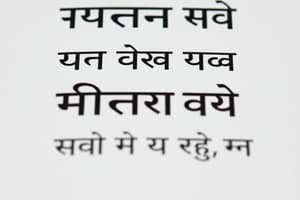Podcast
Questions and Answers
Explain how the historical interaction between Hindi and other languages like Persian, Arabic, and Turkic influenced the development of Hindustani. Why was this significant?
Explain how the historical interaction between Hindi and other languages like Persian, Arabic, and Turkic influenced the development of Hindustani. Why was this significant?
Hindi absorbed Persian, Arabic, and Turkic words during the Delhi Sultanate and Mughal Empire, leading to the development of Hindustani. This fusion facilitated communication and cultural exchange.
Describe the role of Bharatendu Harishchandra in the modernization of Hindi literature. What specific contributions did he make?
Describe the role of Bharatendu Harishchandra in the modernization of Hindi literature. What specific contributions did he make?
Bharatendu Harishchandra played a vital role in modernizing Hindi literature by promoting the use of Khari Boli and addressing contemporary social issues in his works. He helped shape modern Hindi prose and poetry.
How does the geographical distribution of Hindi reflect its historical significance and its role as a lingua franca in India?
How does the geographical distribution of Hindi reflect its historical significance and its role as a lingua franca in India?
The widespread presence of Hindi in the Hindi Belt and other parts of India shows its historical importance and role as a common language. Its presence in diaspora communities further illustrates its global reach and cultural influence.
What are the key grammatical features of Hindi, and how do these features reflect its Indo-Aryan linguistic origins? Provide an example.
What are the key grammatical features of Hindi, and how do these features reflect its Indo-Aryan linguistic origins? Provide an example.
Explain how Devanagari script represents vowels and consonants, and what are some of its unique characteristics compared to other writing systems?
Explain how Devanagari script represents vowels and consonants, and what are some of its unique characteristics compared to other writing systems?
Describe the process of Sanskritization in the context of Hindi's standardization during the 19th century. What impact did it have on Hindustani?
Describe the process of Sanskritization in the context of Hindi's standardization during the 19th century. What impact did it have on Hindustani?
How did the recognition of Hindi as an official language of India in 1950 influence its development and usage in government and education?
How did the recognition of Hindi as an official language of India in 1950 influence its development and usage in government and education?
Discuss the significance of Khari Boli in the evolution of modern Hindi. How did this dialect become the standard form, and what characteristics define it?
Discuss the significance of Khari Boli in the evolution of modern Hindi. How did this dialect become the standard form, and what characteristics define it?
How have Persian and Arabic languages influenced Hindi, and in what specific areas is this influence most evident?
How have Persian and Arabic languages influenced Hindi, and in what specific areas is this influence most evident?
Explain how loanwords from languages like English are adapted into Hindi, providing an example of this adaptation.
Explain how loanwords from languages like English are adapted into Hindi, providing an example of this adaptation.
What role did the Bhakti movement play in the development of Hindi literature, and can you name two prominent poets from this era?
What role did the Bhakti movement play in the development of Hindi literature, and can you name two prominent poets from this era?
How has Bollywood impacted the Hindi language and culture on a global scale?
How has Bollywood impacted the Hindi language and culture on a global scale?
Describe the challenges associated with promoting Hindi in non-Hindi speaking regions of India.
Describe the challenges associated with promoting Hindi in non-Hindi speaking regions of India.
Discuss the significance of the Three-Language Formula in the context of language education in India.
Discuss the significance of the Three-Language Formula in the context of language education in India.
In what ways are digital platforms and the internet influencing the use and development of the Hindi language today?
In what ways are digital platforms and the internet influencing the use and development of the Hindi language today?
How did Bharatendu Harishchandra contribute to the emergence of modern Hindi literature?
How did Bharatendu Harishchandra contribute to the emergence of modern Hindi literature?
What is Hindustani, and why was it considered a significant language in certain regions?
What is Hindustani, and why was it considered a significant language in certain regions?
Explain the ongoing debates about the role of Sanskritization in the evolution of modern Hindi.
Explain the ongoing debates about the role of Sanskritization in the evolution of modern Hindi.
Flashcards
What is Hindi?
What is Hindi?
A major Indo-Aryan language, also an official language of India.
Hindi's Origin
Hindi's Origin
Evolved from Shauraseni Prakrit, with Khari Boli as its standard dialect.
Languages that Influenced Hindi
Languages that Influenced Hindi
Persian, Arabic, and Turkic.
What is the Hindi Belt?
What is the Hindi Belt?
Signup and view all the flashcards
Common Word Order in Hindi
Common Word Order in Hindi
Signup and view all the flashcards
Genders in Hindi Grammar
Genders in Hindi Grammar
Signup and view all the flashcards
What is Devanagari?
What is Devanagari?
Signup and view all the flashcards
Devanagari Vowel Sounds
Devanagari Vowel Sounds
Signup and view all the flashcards
Hindi Vocabulary Origins?
Hindi Vocabulary Origins?
Signup and view all the flashcards
What is Khari Boli?
What is Khari Boli?
Signup and view all the flashcards
Early Hindi Literature?
Early Hindi Literature?
Signup and view all the flashcards
What is Bollywood?
What is Bollywood?
Signup and view all the flashcards
What is Hindustani?
What is Hindustani?
Signup and view all the flashcards
Hindi's Official Status?
Hindi's Official Status?
Signup and view all the flashcards
What is the Three-Language Formula?
What is the Three-Language Formula?
Signup and view all the flashcards
Challenges to Hindi?
Challenges to Hindi?
Signup and view all the flashcards
Current Trends in Hindi?
Current Trends in Hindi?
Signup and view all the flashcards
Bollywood influence?
Bollywood influence?
Signup and view all the flashcards
Study Notes
- Hindi is an Indo-Aryan language spoken chiefly in India
- It is an official language of the Union government of India, alongside English
- Hindi is the lingua franca of the Hindi belt
- Hindi is one of the 22 scheduled languages of India
Origins and History
- Roots of the Hindi language are in the dialects of the medieval Indo-Aryan language, Shauraseni Prakrit
- It evolved via Apabhramsa into early Hindi forms
- Khari Boli, a dialect from Delhi, became the standard for modern Hindi
- During the Delhi Sultanate and Mughal Empire, Hindi absorbed Persian, Arabic, and Turkic words, forming Hindustani
- In the 19th century, standardization efforts led to a divergence from Hindustani, emphasizing Sanskritization
- Bharatendu Harishchandra was key in modernizing Hindi literature
- As of 1950, post-independence, Hindi was recognized as an official language of India
Geographical Distribution
- Hindi is primarily spoken in India's Hindi Belt
- Bihar
- Chhattisgarh
- Haryana
- Himachal Pradesh
- Jharkhand
- Madhya Pradesh
- Rajasthan
- Uttar Pradesh
- Uttarakhand
- Delhi
- Significant Hindi-speaking populations exist in other parts of India
- Maharashtra
- West Bengal
- Gujarat
- Hindi is spoken in diaspora communities worldwide
- The United States
- The United Kingdom
- Canada
- The Middle East
Linguistic Features
- Hindi is an Indo-Aryan language, linked to Sanskrit and other Indo-European languages
- Largely derived from Sanskrit, with loanwords from Persian, Arabic, and English
- Hindi grammar includes features
- Noun-verb agreement
- Postpositions versus prepositions
- Relatively free word order, Subject-Object-Verb (SOV) is common
- Hindi is morphologically rich
- It has three genders
- Masculine
- Feminine
- Neuter (in some dialects)
- Hindi verbs conjugate based on tense, aspect, mood, gender, and number
Writing System
- Hindi is written in the Devanagari script
- Devanagari is an abugida, with each consonant having an inherent vowel (usually 'a')
- Vowels are written as independent letters or as diacritics modifying consonants
- Devanagari is written left to right
- It has 11 vowels and 33 consonants
- Additional symbols and diacritics indicate nasalization and other phonetic nuances
Vocabulary
- Comes from Sanskrit, Prakrit, Persian, Arabic, and English
- Sanskrit provides formal and technical vocabulary
- Persian and Arabic contributed words related to administration, law, and culture
- English has influenced vocabulary, especially in technology and science
- Loanwords are often nativized to fit Hindi phonology and grammar
Dialects
- Includes several dialects and variations across regions
- Khari Boli is the standard dialect
- Other notable dialects
- Braj Bhasha
- Awadhi
- Bagheli
- Bhojpuri
- Bundeli
- Haryanvi
- Kanauji
- Korwa
- Chhattisgarhi
- Magahi
- Nagpuria
- Sadri
- Dialects vary in vocabulary, pronunciation, and grammar
Literature
- Hindi literature has a rich history spanning centuries
- Early literature consists of religious and devotional poetry and texts
- The Bhakti movement saw significant contributions in devotional poetry
- Notable medieval poets include
- Kabir
- Tulsidas (Ramcharitmanas)
- Surdas
- Mirabai
- Modern literature emerged in the 19th century with Bharatendu Harishchandra
- Premchand is known for novels and short stories depicting social realities
- Contemporary literature explores diverse themes and styles
Influence of Hindi
- Has influenced other languages and cultures in India and beyond
- Hindustani, a blend of Hindi and Urdu, served as a common language in many regions
- Bollywood has popularized Hindi worldwide
- Songs, dialogues, and films have impacted popular culture in South Asia
Hindi Cinema (Bollywood)
- The Hindi film industry is based in Mumbai (formerly Bombay)
- Bollywood films have a wide audience in India and among the Indian diaspora
- Bollywood has promoted the Hindi language and culture
- Songs are popular and have contributed to the spread of Hindi vocabulary and expressions
Status and Usage
- It is an official language of the Union government of India
- Used in administration, education, and media
- Taught in schools across India, although instruction levels vary
- Debates exist regarding promotion and imposition of Hindi in non-Hindi speaking regions
- The Three-Language Formula aims to promote Hindi, English, and a regional language in schools
Challenges and Issues
- Faces issues related to promotion in non-Hindi speaking areas
- Language politics and regionalism pose obstacles to widespread acceptance
- Debates continue regarding Sanskritization in evolution
- Preserving the diversity of dialects is also a concern
Current Trends
- Increasing use on the internet and social media
- Online content, including news, entertainment, and educational material is growing
- Used in e-commerce and digital transactions
- Efforts are being made to develop language technology, such as speech recognition and machine translation
Studying That Suits You
Use AI to generate personalized quizzes and flashcards to suit your learning preferences.




